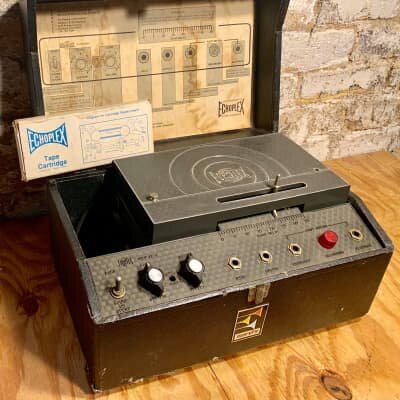The Echorec Delay Sound
The Binson Echorec delay is a sound that many guitarists have heard but aren't aware of. There is an assumption that anything before digital or analog delays are tape-based echos.
Tape echos such as the Maestro Echoplex were produced in quantity and more available in the USA. But tape delay had its issues, and Italian inventor Dr. Bonfiglio Bini designed the Echorec to solve them.
Specifically, the Echorec has a broader frequency spectrum and doesn't have the wow and flutter associated with tape.
What is an Echorec?
A tape echo uses a loop of tape to record and play back a signal. The Echorec uses a magnetic drum. There was one record head and four playback heads placed strategically to produce quarter, 8th, dotted 8th, and 16th note delays.
A selector switch allowed you to choose between various combinations of the playback heads, giving you the option of multi-tape delays.
Phil Taylor of Effectrode has produced some incredibly detailed info about the Binson Echorec. (He’s also written detailed blogs about the restoration of David Gilmore's T7E.)
Tone
The multi-head delay isn’t the only thing that makes the Binson Echorec special. The Echorec T7E model had six 12ax7 tubes. When you plugged a source into an Echorec, it would go on an audio journey through lots of tone sweetening.
Maestro Echoplex
There’s a magic in the circuitry of the Echorec, as with a lot of old analog gear including the Maestro Echoplex. Many guitarists use old Echoplexes primarily as a preamp to get some of that sonic magic.
I say this to emphasize that what makes the Echorec special isn't just its multi-playback heads. Over the years, I've seen attempts at capturing the Echorec sound in delay pedals with no attention to the sonic imprint a real Binson Echorec adds. For me, this is a fail. It’s the equivalent of trying to copy a tape echo by just cutting the high end on the repeats.
Modern
Original Binson Echorecs are not only hard to find but also very expensive and high-maintenance. A lot of Echorec parts are out of production. Good luck finding used parts, too.
So original Echorecs aren’t practical for many of us. Today, we need other ways to get that unique Echorec character.
There are two paths: Plugins and pedals. To this day, nobody makes an updated version of the Echorec. I hope someone has the dedication to recreate one for us tone geeks. Pretty please, Phil Taylor! I know if anyone can make one, it would be you!
Plugins
Pulsar audio makes a plugin called Echorec. Yep—it's a modeled Binson Echorec in a plugin. Pulsar modeled three Echorecs at varying operation quality.
Space maker
The most prominent character I associate with the Echorec is how it feeds back without overwhelming the signal.
The delay can almost become a reverb sustain-like effect. The Echorec can be ghostly.
The Pulsar gives us two options to create a swirling, ghostly echo—RIP and Swell modes. There are times when I will let the Pulsar Echorec oscillate in the background of a lead guitar part.
It's another way to create space without using reverb, which can sometimes overwhelm sound.
You can also use the Echorec in Echo mode, which disables the feedback knob.
Time
On the original Binson Echorec you couldn't adjust the time. The Pulsar version allows you to tap in a tempo or sync to your DAW—a welcome addition for modern production.
When used on a stereo track, the Echorec’s Stereo drift feature allows you to create a wider stereo field by fluctuating the left and right delay timing.
Easy peasy
I find myself experimenting a lot with the Pulsar Echorec plugin. It's pretty easy to get a great sound. I don't find myself struggling to be inspired. But I do like twisting the tone, drive, and age knobs to see how they interact with the part.
A true clone?
The Pulsar Echorec is an inspiring plugin. But does it sound like an original Binson Echorec T7E?
The truth is, I don't have access to one for comparison. And even if I did, there is always variance in old analog gear. An original Echorec can vary from unit to unit, for several reasons.
“I hear the spirit and vibe of an Echorec in the Pulsar Echorec.”
My point? We can argue that it may not sound exactly like an original Echorec, but isn't that unproductive? I hear the spirit and vibe of an Echorec in the Pulsar Echorec. It’s clear that Pulsar loves the original Echorec—and has managed to get a lot of its vibe into the plugin.
Until someone starts making a new version of the Binson Echorec (which would be way more expensive than the plugin), we don't need to measure so carefully.
Pedal format
Of course, a plugin isn't ideal for guitarists who want the Echorec tone in front of their amps. Fortunately, there is an excellent option in the Strymon Volante.
Strymon has done a pretty great job of emulating tape echo with the El Capistan. I own a real tape echo, and sometimes I use the El Capistan because has a unique sound.
Is it exactly the same as my tape echo? No. But it does a fantastic job of implying a tape echo’s character. What it lacks is that special something present in the preamp. But that’s me being picky, because the El Capistan sounds excellent!
“Strymon has come the closest to embodying the drum echo tone in a pedal. ”
Strymon has gone to great lengths to recreate the interaction of drum echos. They've even added some modern features for working in stereo. Strymon has come the closest to embodying the drum echo tone in a pedal.
Although there are a few other choices for an Echorec in a pedal, I don't believe they come as close in their tone as the Volante.
In use
David Gilmore of Pink Floyd is the most notable user of the Binson Echorec. You can hear Echorec delay all over The Dark Side of the Moon.
I happen to be a fan of the British surf band The Shadows. The Shadows’ Hank Marvin is one of my favorite guitarists. Hank used an Echorec into a Vox AC30 on many Shadows recordings between 1964 and 1975. On the songs "Apache" and "Man of Mystery," you can hear a Meazzi Echomatic drum echo.
Guitars aren't the only instruments that can benefit from an Echorec. Led Zeppelin used a Binson Echorec for its now-legendary drum sound on "When The Levee Breaks."
If you're into delay, an Echorec style plugin or pedal is a must-have. For me, it fills in space that other delays can't. It can be present and unobtrusive. The Echorec is one of the best-kept secrets in guitar tone.
Let's listen to some examples of the Pulsar Echorec plugin:














